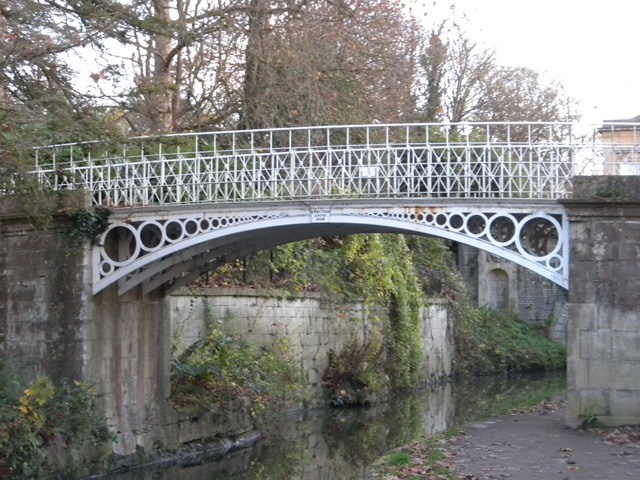We Recommend:
Bach Steel - Experts at historic truss bridge restoration.
Sydney Gardens Bridge

Primary Photographer(s): Bob Dover
Bridge Documented: December 1, 2014
Bath: South West, England: United Kingdom
1800 By Builder/Contractor: Coalbrookdale Company of Coalbrookdale, Shropshire, England
Not Available or Not Applicable
Not Available
Not Available
Not Available
1 Main Span(s)
Not Applicable

View Information About HSR Ratings
Bridge Documentation
This is a very old example of a cast iron arch bridge and was cast by the famous Coalbrookdale Company.
Bob Dover provided the following information:
This is a tiny cast iron arch footbridge over a canal in a city park, which is not located very close to the tourist center of Bath. You would be unlikely, as a tourist, to come across this bridge on your own, and even experienced seekers of historic bridges will have to do some work to find it. But it is worth it, as it has a delightfully quirky design of graduated circles forming its arch. It also proudly display its construction date on a plaque above the arch, reading “Erected Anno 1800”. It is just a few steps from a similar cast iron bridge which has a similar “Erected Anno 1800” plaque on it. This one is of different construction, and is not nearly as ornate.
Official Heritage Listing Information and FindingsListed At: Grade II* Discussion: List Entry Number: 1395952 |
![]()
Photo Galleries and Videos: Sydney Gardens Bridge
Bridge Photo-Documentation
Original / Full Size PhotosA collection of overview and detail photos. This gallery offers photos in the highest available resolution and file size in a touch-friendly popup viewer.
Alternatively, Browse Without Using Viewer
![]()
Bridge Photo-Documentation
Mobile Optimized PhotosA collection of overview and detail photos. This gallery features data-friendly, fast-loading photos in a touch-friendly popup viewer.
Alternatively, Browse Without Using Viewer
![]()
Maps and Links: Sydney Gardens Bridge
Coordinates (Latitude, Longitude):
Search For Additional Bridge Listings:
Additional Maps:
Google Streetview (If Available)
GeoHack (Additional Links and Coordinates)
Apple Maps (Via DuckDuckGo Search)
Apple Maps (Apple devices only)
Android: Open Location In Your Map or GPS App
Flickr Gallery (Find Nearby Photos)
Wikimedia Commons (Find Nearby Photos)
Directions Via Sygic For Android
Directions Via Sygic For iOS and Android Dolphin Browser
Ordnance Survey Maps (UK Only)

